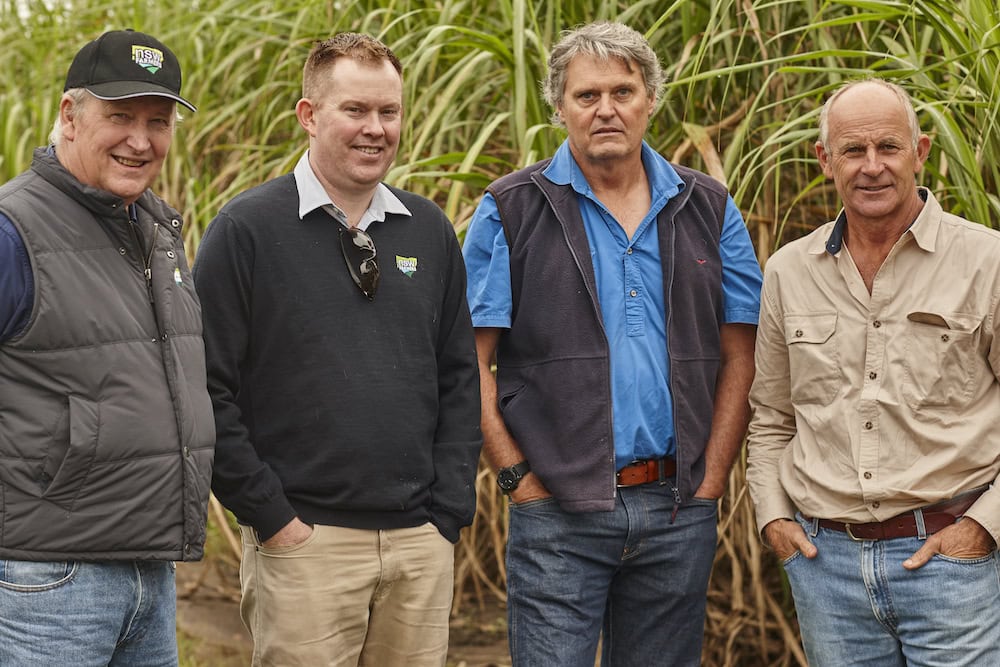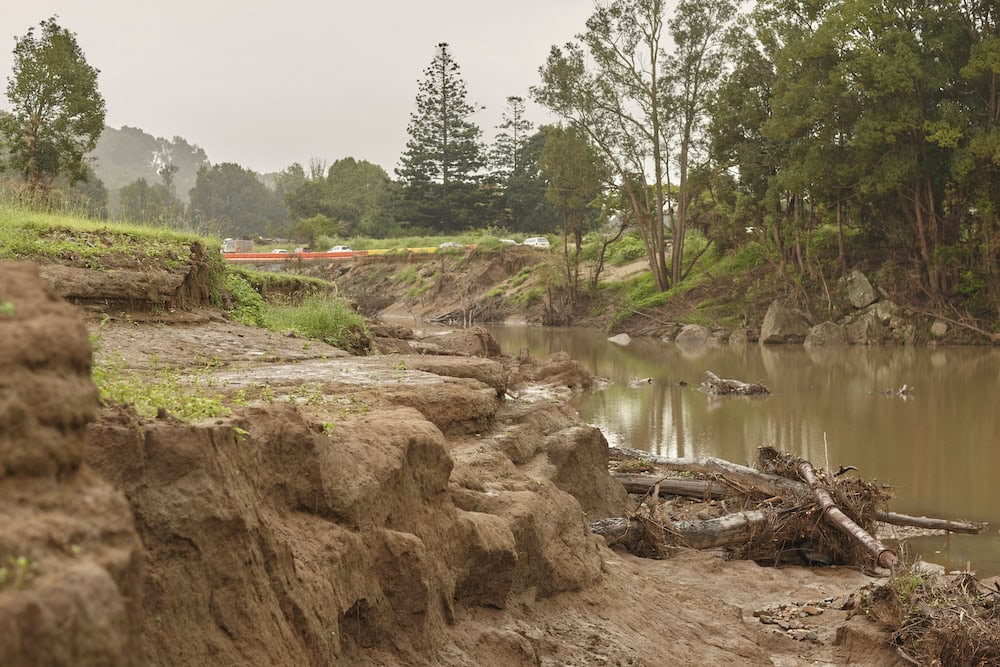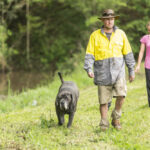Fires, floods and drought are natural disasters that farmers and those living in rural and…
After the floods � a long road to recovery

Most of the Baker family�s 160-hectare historic Tweed Valley farm was swamped by floodwaters on February 27, after the upstream catchment received 1,300mm of rain in 36 hours.
�Our annual average rainfall is 1,850mm, so to have that amount of rain in such a short time is astounding,� Neil Baker says. �It caused a flood that was catastrophic. There are no other words to describe it.�
Neil�s father Bruce is 95, and he says he has never seen a flood like it in his lifetime.

The Baker family has been on the same Tweed Valley farm near Murwillumbah for 112 years. Neil now runs the farm business with wife Michelle and son Liam, producing grass-fed beef and free-range pork. Bruce still lives on the farm and remains an integral part of the business.
While the Baker family did not lose any livestock, it was a testing time for their cattle herd and semi free-range pigs, who normally have a stress-free life grazing on lush pastures along the Tweed and Oxley Rivers.
Luckily, they have been able to keep their Tweed Valley Beef and Tweed Valley Pork brands on the menu for local customers and butchers.
�There were lots of transport interruptions and we have had to reduce cattle numbers, but we have been able to keep some supply going,� Neil says. �The issue now is just being able to get onto the paddocks to sow winter pastures and get some fences back up.
�The ground is so muddy, and the rain just keeps coming. We have only been able to plant a small amount of rye grass and it�s hard to rotate stock with no fences.�

The family lost all of their fences on their floodplain, so now there�s about two and half kilometres of fencing to replace.
�I�d estimate that we would have 15,000 to 20,000 cubic metres of silt on our flats now. In time that will benefit our pastures, but for now it is definitely not pretty, and makes access very difficult.
Neil Baker.
�Prior to the floods in February, we were looking at a screamer of a year. Things change so quickly.�
Assistance for recovery after the floods
The Baker family has been approved to receive a $75,000 primary producer flood recovery grant, which will be used to replace fencing, repair internal roads on the farm, clean out drains and culverts and replant pastures.
�It is going to be a long-term process,� Neil says. �We�re talking at least a few years here on our farm, and repairing the erosion and damage to the four kilometres of riverbank we have will take even longer.�
The Baker family had been progressively revegetating riparian zones over the past 30 years, planting around 5,000 native trees and plants along the Tweed and Oxley Rivers.

�The trees were completely destroyed and washed off the property, and we lost about another 10 to 15 metres of riverbank,� Neil says.
�There is always room to improve and adapt when it comes to farming. That�s one of the reasons why we have been revegetating the riverbanks, to preserve them for future generations. So it�s really disappointing to lose all of that, but we will recommence the project as it is the only way to protect our farm�s future sustainability.�
Neil Baker
Some helping hands go along way
The Bakers were one of 48 flood-affected farming families in the Tweed Valley region to receive a share of $380,000 in direct assistance from Queensland-based charity Aussie Helpers, immediately after the floods.
Neil says the assistance from Aussie Helpers at that time �was simply brilliant�.
�They helped organise fodder and fencing materials, provided fuel cards and a pre-paid $500 credit card. It was immediate assistance, which is what was needed.�
Aussie Helpers returned in May to follow up on farmers they visited and arranged a barbecue and gathering for them at the showground. �Everyone appreciated the chance to socialise and to wind back momentarily,� Neil says.
Aussie Helpers CEO Tash Kocks joined three other Aussie Helper team members on the four-day visit to the Tweed region in March, after the charity received an influx of calls from farmers.

�We prefer to do things face-to-face as it works for farmers,� Tash says. �We want to go out to meet them and hear what they are going through and identify immediate needs like fencing, feed and water tanks.
�This way, farmers also don�t have to jump through hoops to get the assistance they need.�
Tash says conversations that she and the team had with some Tweed Valley farmers were tough, but they were also part of the healing process.
�They all thought that everyone was worse off than them, but they were all a bit broken and hurting,� she says.
�One farmer told me that he had never seen her dad cry and he is in his eighties. She said he just sobbed because he had never seen water like that in his life. A lot of the farmers said the financial stuff is great, but just being able to have a conversation with someone benefited them so much more.�
Aussie Helpers CEO Tash Kocks.

After the floods, where there�s a will there�s a way
Neil says support from NSW Farmers and local state member Janelle Saffin inspired him to move forward with his generational farming business.
�Through NSW Farmers, I was able to provide feedback about the impact directly to the Agriculture Minister shortly after the floods, and have input into appropriate assistance measures,� he says.
Other charities such as Lions Need for Feed and Rural Aid also rushed fodder and support to Northern Rivers farmers, while farmers in other parts of the state teamed up to donate fodder and cash.
The NSW Farmers Glen Innes branch supported a special �Thinking of our Fellow Farmers Flood Appeal� cattle sale at the Glen Innes saleyards, which raised more than $49,000 to donate to farmers in the Northern Rivers region.

Glen Innes branch Chair Kylie Falconer said local members were pleased to participate in the event. �Raising that sort of money is something that everyone involved can be proud of,� Kylie says.
�Farmers in our region really appreciated the support we got during the drought, and this was a way to give back to the farmers that supported us.�
The funds will be donated to the NSW Farmers Natural Disaster Relief Fund for distribution to farmers in the Northern Rivers region.
Rivers need help for future floods
Tweed Valley sugarcane farmers and the farmer-owned Condong sugar mill felt the full force of the February flood.
The sugarcane plant is a tough one, and it has survived many floods since first being planted in the region in the 1870s. But the force of the 2022 flood has truly tested its resilience.
Tweed Valley Canegrowers Association Chair Robert Hawken said farmers are estimating a 25 per cent decrease in yield and a delayed start to harvest.

�If it keeps raining like they are predicting, it will be extremely difficult to get a June start to harvest, which has impacts through the whole supply chain,� Robert says.
While this year�s harvest is top of mind, Robert said the region�s farmers want action from Tweed Shire Council on desilting the Tweed River system to clear the way for future floods.
�Just as we farmers need to regularly maintain our cane drains and canals, the valley�s main drain � the Tweed River � requires urgent and strategic desilting of the channels and removal of obstructions.�
Tweed Valley Canegrowers Association Chair Robert Hawken.
�The enormous silt loadings in the floodwater were very obvious in the clean up after the event. When these dirty floods occur, large volumes of silt settle in downriver areas, on the farmland, roadways, urban areas and in the river channels.
�No one can control or even predict this type of torrential rainfall, but I believe we can improve the river�s ability to discharge the massive volume of water to the ocean as quickly as possible.�

Robert admits that they�ll never be able to stop these types of flood events, but says that they all must do everything to prevent major losses to the community.
Neil agrees, saying that parts of the river systems have not be dredged for more than 40 years.
�There is a consensus from all of the farmers that the Tweed Shire Council is ignoring them on a lot of issues, including the need for a full hydrological study of the riverine system and a plan to desilt our waterways.�
Neil Baker.
�With the repair works that are needed now, and the extent and severity of the erosion at present, it is appropriate for the state government to get involved.�
Farmers recommend flood response changes
According to NSW Farmers, more frequent, intense storms will require swift defence force deployment and streamlined government support.
In a submission to the NSW Parliament Select Committee Inquiry on the Response to Major Flooding Across NSW in 2022, the state�s peak farming body made nine recommendations to improve reactions to natural disasters (see page 24).
NSW Farmers CEO Pete Arkle said food and fibre production in regions like the Northern Rivers had been catastrophically impacted by rain events since March 2021, resulting in significant hardship for town residents and businesses, and particularly the farming?community.
�We�ve seen some communities smashed by two or even three major flooding events in a 12-month period, which is absolutely unprecedented,� Pete says.

�We�ve seen the resilience and productivity of our farming communities sorely tested since late 2017, when severe drought took hold. Since then, we�ve had destructive bushfires, a mouse plague, a global pandemic and now these terrible storms and floods. Communities are hurting.�
NSW Farmers CEO Pete Arkle.
Pete adds that the unprecedented scale of the storms and floods of the past 15 months has left many with considerable damage that will take years, rather than months, to identify, restore, and repair.
�We have highlighted this extended impact in our submission to the inquiry as for many primary producers the effect of natural disasters or critical global events is both immediate and delayed,� Pete explains.
�Once you get over the immediate devastation, there is the long-term impact on your business, and in turn that has a long-lasting impact on local jobs and communities.
�Ultimately, the challenge for primary producers, as with other residents, is now the transition from emergency response to recovery and rebuilding.�
Pete says the emergency response provided to farmers by the Department of Primary Industries and Local Land Services had to be recognised and acknowledged, calling it swift, professional, and relevant to the immediate need.

9 flood response recommendations from NSW Farmers
Recommendation 1:
An agreement to be negotiated between the NSW and Commonwealth Governments to ensure that the Australian Defence Force (ADF) on-the-ground support be activated as soon as natural disasters occur to ensure the most timely emergency response.
Recommendation 2:
Priority be given to the establishment of renewable energy micro-cells on farms and on telecommunication infrastructure to aid farmers, rural landholders, and telecommunication providers mitigate the impact of the loss of production and connectivity as a consequence of natural?disasters.
Recommendation 3:
Fair Trading NSW to establish and broadly communicate a single point of contact for businesses recovering from flood events to mitigate any unconscionable practice by providers and contractors undertaking emergency repairs following floods and other natural disasters.
Recommendation 4:
Given the increasing frequency and severity of natural disasters, a review of the cost of insurance premiums to be undertaken, with a particular focus on the Emergency Services Levy?component.
Recommendation 5:
The Harvestable Rights limit in coastal draining catchments is increased to 40 per cent productive use in appropriate?catchments.

Recommendation 6:
Review the process for multi-agency input for Natural Disaster Declarations to ensure the most appropriate data is collected across all community and business impacts and increase?transparency.
Recommendation 7:
Additional funding be allocated to the NSW Rural Assistance Authority to deliver improvements to the automation of the grant assessment process.
Recommendation 8:
Consideration be given on a sliding scale of support for smaller or establishing primary producers based on percentage of off-farm income against net primary production income where the landholder has a right or interest in a farm enterprise, and contributes a part of his or her labour and capital to the?enterprise.
Recommendation 9:
Consideration be given to identifying alternate processes to confirm expenditure for natural disaster rectification work where third party contracting arrangements may not be the most cost effective or timely option?available.
If you enjoyed reading this feature on farmers recovering after the floods, you might like our story on improvements in communication and connectivity on farms.








